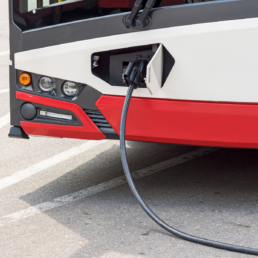Ten truths about electric trucks and buses
Lice-cycle GHG emissions
Battery electric trucks have the lowest life-cycle GHG emissions
This is true from 16-40t trucks, according to a study by Ricardo Research (2020), which compared emissions of the differing drivetrain technologies based on a WTW approach. The emission-saving potential of electric vehicles (EVs) increase when entirely powered by renewable energy (up to 81%) compared to a fossil-powered alternative as shown by study ICCT (2021) undertaken in passenger cars. As battery-eletric trucks (BETs) have outstanding energy efficiency, lifecycle emissions decrease with every additional kilometre driven, meaning that long-distance trucks have particularly high emission-saving potential.


Energy efficiency
Battery electric trucks offer a dramatic improvement of energy efficiency
BETs offer a dramatic improvement of energy efficiency, i.e. the ability to drive a greater number of kilometres on the same amount of energy. The JRC, EUCAR and Concawe (2020) have updated their joint evaluation of the WTW energy use and Greenhouse gas (GHG) emissions for a wide range of powertrain options. Considering only zero-emission technologies on Wheel-to-Well (WTW) basis, BETs using green electricity - both regional and long-haul - are 2.6 times more energy efficient than the green hydrogen-powered fuel cell equivalent. Although synthetic fuels were evaluated for cars rather than trucks, as an indication a battery electric car using green electricity is 6.9 times more energy efficient than a combustion vehicle using e-fuel.
GHGs and air pollutant
Battery electric buses do not produce local GHGs and air pollutant emissions
Battery-electric buses (BEBs) do not produce local GHGs and air pollutant emissions, providing considerable health benefits, particularly in cities. Because they are powered by electricity, the higher powertrain efficiency means that BEBs emit 73% less CO2 equivalent than diesels, rising to 90% if powered by 100% renewable sources. In contrast (according to ICCT (2022)),Compressed Natural Gas (CNG) CO2 emissions are nearly 30% lower than a diesel, but its higher energy consumption - 24-50% per kilometre - reduces this advantage. In addition, methane is a potent GHG with a global warming potential more than 80 times greater than CO2 over a 20-year period; unintended leakages during extraction and transport further exacerbate the situation.


Intermodality
BETs will contribute to the further greening of intermodal transport
BETs will contribute to the further greening of intermodal transport, as well as improving the overall energy efficiency of freight logistics. Synergies between rail, road transport and inland waterways are crucial to the logistics system. These offer benefits for the whole supply chain, as intermodal transport helps reduce congestion in urban areas while potentially increasing capacity in and around cities. Tangible examples of intermodal links have been successfully deployed in Paris’ metropolitan area. Companies such as IKEA and Franprix supply stores in Paris are using a combination of electric ships and electric road transport solutions for the last-mile segment.
Electricity grid
With smart grid technologies, the grid would need little adaptation for BETs and BEBs.
With smart grid technologies, the grid would need little adaptation for BETs and BEBs. Uni- and bi-directional charging enables a double optimization of the load at the depot. Optimising the grid connection and allowing the monetisation of the vehicles' flexibility capabilities makes them valuable assets, even when parked: it also provides the grid with supplementary battery capacity. Vehicle-to-grid (V2G) is performed at much lower power levels than in regenerative braking or fast charging.


Cost
By 2030, 99.6% of new BETs will be cheaper to own and run than diesel trucks
By 2030, 99.6% of new BETs will be cheaper to own and run than diesel trucks while carrying the same weight of goods over the same distance and journey time, according to a study by TNO (2022). This study is based on the total cost of ownership (TCO), the most important economic indicator for a truck. It covers those deployed in urban and regional delivery over distances of 300 km as well as long-distance trucks travelling 800km/day. Due to the savings from using electricity rather than diesel, the cost-saving potential of BETs increases with every additional kilometre driven, meaning that by 2035, long-distance trucks will be the most cost-efficient solution in Europe.
Investment costs of battery elecric buses
Higher investment costs of BEBs offset by lower electricity consumption and maintenance costs.
Similarly, the higher investment costs of BEBs are offset by their lower electricity consumption and maintenance costs (in Spain and Latin America in 2021 and in Italy, US and UK by 2023). Bocconi University and Enel Foundation (2021) integrated well-known TCO (the initial investment in purchasing vehicles and the charging infrastructure, plus the operational and maintenance costs) with peculiar to BEBs circular economy revenue streams, by the second life of batteries and V2G. This explains why buses are now the fastest-growing zero-emission vehicle segment, making up 23% of new city buses in 2021, up from 16% in 2020. Considering the revenues from V2G and second life, BEBs are more cost effective than diesel and CNG buses.

Payload
Urban and regional trucks can already have as much payload capacity as their diesel counterparts
Urban and regional trucks can already have as much payload capacity as their diesel counterparts today, according to a recent study by TNO. While the battery of an electric long-haul truck currently may weigh several tonnes, depending on its size, the so-called 'ZEV weight allowance' grants an additional two tonnes to zero emission trucks on European roads. This, along with improving vehicle energy efficiency and battery energy density, will eliminate any payload loss by the end of the decade, even for long-distance trucks with 800km range.
Range
BETs already have more than sufficient range to cover freight transport routes in Europe
BETs already have more than sufficient range to cover freight transport routes in Europe, something that will continue to improve. With the compulsory 45-minute break every 4.5 hours, and given that they have a maximum permitted speed of 90km/h, trucks will never drive more than 400 km without having to stop. Tesla has begun deliveries of the ‘Tesla Semi’, a clean-sheet design BET with a real-world range of 800km when fully loaded. The EU’s Weights & Dimensions Directive allows ZETs to be increased by two tonnes over that of diesel trucks. This allowance alone already increases the payload-neutral range of electric trucks by over 300km.


Extreme conditions
BETs are as competent as diesel trucks in extreme cold.
BETs are as competent as diesel trucks in extreme cold. In February 2021, Volvo Trucks, ABB and Vattenfall - together with a local mining company - ran a trial on replacing the diesel transport of iron ore with BETs. The ore is taken from a North Sweden mine to the railway transfer station, in temperatures of -30C°. The BETs were used for the journey from the mine to the transfer station where they could unload the cargo while recharging batteries following a 280km round trip normally undertaken by diesel-powered vehicles. The Polar Winter Project proved the feasibility of electric transportation in extreme conditions. The BETs were able to drive the entire distance - including 140km with 14t of ore on board, at temperatures as low as -32C° - while taking the same amount of time as the diesel trucks.
BET Battery Electric Truck
GHG Greenhouse Gas
EV Electric Vehicle
WTW Wheel-to-Well
BEB Battery Electric Bus
CNG Compressed Natural Gas
V2G Vehicle-to-Grid
HDV Heavy-Duty Vehicle
LFP Lithium iron phosphate
TCO Total Cost of Ownership
ZEV Zero-Emission Vehicle
ZET Zero-Emission Truck
JRC Joint Research Center
EPBD: 3 Pillars to ensure the private charging of EVs
3 Pillars to ensure the private charging of EVs
As 90% of all charging takes place at home or in the workplace and 80% of the EU’s current building stock will still be in use by 2050, private charging is key to the growth of electromobility. Only an ambitious revision of the EPBD (Art. 12) can make it happen.
for multifamily dwellings
Pre-cabling
If a building is not pre-cabled in the construction or major renovation phase, it can be 9 times more expensive to install cables in the latter stage. It'd lead to highly cumbersome discussions with project developers which can take over 6 months in problematic cases to install a charging station. The pre-cabling should cover both technical and electrical installations for the seamless future installation of recharging points.
for users and grid
Smart functionalities
Smart charging (uni- and bi-directional) can reduce one-third of the EV users' electricity bill. Moreover, it would facilitate the integration of the renewable energies into the grid, reduce the electricity consumption during peak hours and provide flexibility services to the system.
For existing buildings
Right-to-plug
Those advantages would not be reached without removing administrative barriers to installing a charging station, especially the delays in multifamily buildings. Time between application and installation should not exceed 3 months.
EU Year of skills: making the Green Deal works for everyone
EU Year of Skills
Our recommendations to make Green Deal works for everyone
A 2021 study undertaken by the BCG looked into the opportunities and challenges created by the transition of the automotive industry towards electrification. The study shows that shift to EVs will have only a minor net impact on jobs through to 2030.
The relatively small net impact should not, however, obscure the massive structural changes resulting from electrification. Changes in production will modify both the skills requirements and distribution of labour. Over the next decade, direct employment in carmakers and ICE-focused suppliers will decrease by 5%, while the workforce in adjacent industries’ will increase by 34%. On top of this large transfer from core automotive industries to adjacent industries, a further 40k jobs will be created each year in construction and civil works for adapting energy production and distribution infrastructures needed for electrification.
By 2030, the job profile of 2.4mn positions will change, with different degrees of training needs to prepare them for future job demands, which means 42% of all employees in the core automotive and adjacent industries will have dedicated training needs. Specifically, 1.6mnwill require retraining, while remaining in their current position; another 610k will need requalification while remaining in the same industry cluster; and 225k people will need support to requalify for work in other industries outside the automotive ecosystem. Some regions – those more dependent on the traditional automotive sector – will feel this impact more acutely, so it is vital that governments provide policies and support to help those regions adapt to the coming change.
The right political and regulatory choices will help workers fully grab the upskilling opportunity created by the transition to electromobility. To support workers during this transition: the EU, governments and companies should prioritise programmes that invest in the education, training, upskilling and reskilling of the labour force to capitalise on new opportunities, raising the bar on employment conditions, to ensure no one is left behind.
The social changes triggered by the Fit for 55 should be tackled with similar levels of ambition by empowering companies, governments and regional authorities to equip the workforce with new skillsets.
Workers in the automotive sector should benefit from a policy framework similar to the Just Transition Fund, Just Transition Platform and Just Transition Mechanism for the energy-intensive industries and assist industrial stakeholders, local, regional and national authorities to:
For industrial stakeholders, support will be needed to design requalification and upskilling programmes and hiring as well as restructuring programmes. Rapid growth of adjacent industries (like battery manufacturing and charging stations operations and production) should be underpinned by ambitious requalification and upskilling and targets. Support should be provided, particularly for SMEs and fast-growing enterprises, as they will lack the analytics and training resources of bigger companies.
Relocations should be avoided where possible by adapting existing production plants, and training for new skills where they are needed. Via their industrial, attractiveness and educations competences, local and regional authorities will play a key role in addressing the knowledge gaps in the workforce. The new ESF+ should be an instrument for supporting local and regional authorities.
Governments need to perform ‘whole-of-economy’ workforce planning in close cooperation with regional and local authorities and industrial stakeholders to:
- Help employers and employees manage their transitions.
- Tailor educational curricula towards new automotive technologies.
- Build new career and employment platforms to help workers navigate to jobs and training opportunities.
- Increase student seats at universities in new automotive technologies and production/process engineering.
Source: https://web-assets.bcg.com/82/0a/17e745504e46b5981b74fadba825/is-e-mobility-a-green-boost.pdf
Critical Raw Materials Act: Our response to the EC's consultation.
Critical Raw Materials Act
Our feedbacks to the European Commission
The vital transition away from fossil fuels towards cleaner technologies for transport will drive, depending on the technology, the demand for raw materials like lithium, nickel. Whilst some CRMs are available in the EU, Europe is largely dependent on third countries for mining, processing, refining and recycling, even more so in the case of batteries needed for EVs and considering the current geostrategic tensions. We would therefore strongly welcome a CRM package beginning of 2023 to tackle our three concerns:
With the e-mobility transition, the EU is lacking an EV value chain beyond battery manufacturing – i.e. extraction, refining, processing, and recycling, which today is located in third countries – and a coherent approach of using existing EU sources of battery materials.
Hurdles to permitting is due to a) the plurality of mining codes in Europe bringing different levels of ambition and lack of coherence across Member States. This leads to, in some cases, not having any safeguards in relation to social or environmental protection; b) lengthy permitting processes when multiple permits are required for both renewable energy production and sustainable mineral extraction projects; c) lack of expert capacity to ensure the efficient, robust and timely evaluation of Environmental Impact Assessments and Area Assessments.
Limited amounts of sustainably sourced materials, notably due to limited geological mapping of available resources. Barriers also exist to the reuse and repurposing of EV parts that could extend the lifecycle of CRMs before recycling.
Critical Raw Materials Act should therefore:
Include a single strategy on raw materials that defines expected needs, challenges, priorities and key lines of action with specific objectives of reducing the need of primary CRMs, with efficient reuse and recycle.
Assess the need of stockpiling mechanisms.
Provide financial, political support (e.g. tax reductions) to economic actors meeting the highest existing environmental and social standards. For EU-sourced material, the initiative would then work in relation with the package of environmental policies that control impacts from its domestic mining and refining operations and the high EU social standards.
Incentivise keeping valuable battery material in Europe, available for domestic recyclers, justifying their investments in EU today and incentivise the recycling of production scrap and blackmass/BAMM in EU.
Ensure the sustainability of CRMs by addressing adverse environmental and social impacts of their production or recycling. For imports, supply should come from responsible sources with robust certification, due diligence rules setting legal requirements for suppliers to control risk across their supply chains.
Support geological surveys to determine accessibility of domestic resources, including waste.
Mandate specific marking for any product containing CRMs to facilitate their recovery and recycling.
Streamline robust permitting processes without undermining existing environmental laws and in compliance of ESG criteria.
Support permitting authorities with additional expert capacities.
Digitalize permitting processes to ensure transparency and full engagement from project developers to local communities.
Support financially the development of recycling capacities as all recycling activities are not financially viable today due to the low cost of some primary resources. Support for the development of recycling capacities is indeed crucial to the circularity and sustainability aspect of CRM sourcing.
Ensure consistency across different pieces of legislation – notably the proposed lithium salts classification – and make sense of the needs of the CRM demand sector.
Give the ERMAlliance the overall view of EU levers and make it a driving force behind the implementation of the strategy.
Eight steps for an efficient legislation to increase the share of zero-emission vehicles in corporate fleets
Greening corporate fleets initiative
Eight steps for an efficient European legislation in 2023
In June 2022, the European Parliament voted for a de facto ban on sales of internal combustion engines (ICE) vehicles by 2035. To reach this objective, the Parliament also voted in favour of creating additional measures, notably to support the demand for zero-emission passenger cars and light-commercial vehicles (ZEV) within the Union market (AM. 80). It is essential that these accompanying measures are as ambitious as those of the end goal. A fleet mandate to cover the period prior to 2030 would ensure that demand meet supply.
In May 2021, the Platform for electromobility, an alliance of 40+ industries, NGOs and associations covering the whole value chain and promoting the acceleration of the shift to electric mobility, outlined the benefits and opportunities of dedicated legislation to complete the decarbonisation of corporate fleets. This paper now provides policy makers with overarching principles that should lead the elaboration of the upcoming legislative proposal that will bind the electrification of corporate fleets.
1. Standalone legislation on private fleet
As indicated by the use of the plural ‘proposals’ in the approved text, we recommend that the European Commission prepare two separate, dedicated pieces of legislation; one on the private fleet, the other on the public fleet. While the latter should be addressed in the revision of the Clean Vehicle Directive (CVD), and invite Member States (MSs) to lead by example with ambitious electrification plan for public authorities’ fleet, we must note that 99%1 of fleet-owned cars are the property of private individuals. The dynamics between private and public fleets are also different in areas such as size, procurement rules, and thus should be treated separately. In addition, as the first reference period under the CVD has only just begun, we believe any revision to the Directive would be premature.
The priority should therefore be given to address the decarbonisation of private fleets, which represent more than 60% of EU sales.
2. Need for a Regulation
While the revision of the CVD is appropriate to decarbonise the public fleet, we believe a Regulation, rather than a Directive, is essential to electrify the private fleet. A Regulation would:
- Stimulate deployment of electric mobility throughout the EU before ICE phaseout, by accelerating decarbonisation of the corporate cars that drive more than 2.25 times further than individually owned cars.
- Boost zero-emission uptake in the B2B segment, for which the total cost of ownership is superior, because of higher annual mileages.
- Create a plentiful second-hand market that ensures affordability of zero-emission vehicles before 2035.
- Avoid the delays in implementation that a Directive might entail, such as those that can currently be seen with the Clean Vehicle Directive. While climate change remains an ongoing threat, the time needed to conclude negotiations on a Regulation would be compensated for by the inevitability of its direct implementation. A Regulation will reduce the transition time to electric mobility between those Member States that have already announced the phaseout of ICEs by 2030 and those yet to do so.
- Bring certainty to both EV manufacturers and those companies purchasing targeted fleets. Such certainty for manufacturers, along with ambitious CO2 emission performance standards for new cars and vans, will ensure that the supply of EVs is able to meet the EU’s climate ambitions. It will also help avoid companies competing for a limited supply of ZEVs.
- Introduce stronger safeguards than a Directive against potential Member State market distortions, notably in the form of unfair price increases for the private fleet owners.
3. Almost-complete decarbonisation by 2030
The final target should be 95% of new fleet purchases of passenger cars to be ZEVs by 2030. The last 5% would be difficult to decarbonise, both technically and economically, due to the existence of some specialty vehicles. Setting the final target at a lower level, or after 2030, would not unlock the 10 benefits of mandating the decarbonisation of corporate fleets.
In the area of light-duty vehicles, the market of vans is more limited in supply compared to passenger cars. Therefore, the sector should have both a dedicated trajectory and a dedicated fleet size threshold, above which the Regulation will apply. Vans, with their own specificities, cannot follow at the same pace as cars. Their lifecycle is longer (28 years average) and their usages are usually unique and adapted to specific professional needs. In order to respect the nature of this market, targets must be adapted accordingly. Platform members agree on the need to build a dedicated trajectory and targets for Light Commercial Vehicles (LCVs), although an impact assessment is needed to shape the timeline and the curve appropriately.
While a 95% final target for passenger cars would already ensure a certain level of flexibility, the text voted by the Parliament invites the Commission to also take into account regional disparities.
4. Flexibility measures
Targets should therefore be set at EU level rather than differing targets per Member State. This would prevent some arbitrage strategies from manufacturers and overpricing in those countries in which targets would have been higher.
Setting targets at a European level, based on a certain fleet size, would also ensure that large companies meet the fleet target in each Member State in which they operate. This would ensure that separate strategies are not in place in different countries. Currently, in the numerous electrification strategies of companies operating across Europe, efforts are being centralised on more advanced markets, setting aside those markets where electrification of transport is lagging behind. This must change, as a ZEV second-hand market should be developed in CEE Member States as a matter of urgency.
Given the need to decarbonise the B2B segment in every Member State, while simultaneously taking into account the current differing starting points and ability for companies to effectively procure new
ZEVs, we strongly suggest two types of flexibilities that could be granted. One, a delay of a maximum of two years of the mandate, and two, an increase in the minimum fleet size to which the mandate applies.
It is important that, when it comes to eligibility for such flexibilities, the two types should be applied either at Member State level or at company level. Whichever option is chosen, the flexibility requests should be reviewed and assessed by the European Commission to ensure harmonisation at EU level.
Flexibility is essential to ensure the fair transition to clean fleets, as are interim targets:
5. Interim targets
Interim targets are essential to ensure a gradual and smooth transformation of the European private fleets. Without ambitious short-term targets, and even taking into account the proposed flexibilities above, fleets covered by the Regulation would need to undergo drastic change shortly before the final deadline. An unanticipated increase in demand risks triggering uncertainties not only for the business models of fleet owners and users but also for the availability, sustainability and security of the value chain for ZEVs. Hence the importance of ambitious interim targets, clearly set ahead, to increase visibility for car manufacturers and fleet managers alike. The objective of the Regulation is to accompany the shift introduced by the de facto ban on sales of ICE vehicles for users, but also to ensure demand matches supply all along the transition.
Although setting an interim target for 2025 may seem a tight timeline for a legislation to enter into force in 2024, a 2025 target close to half of all newly procured vehicle in corporate fleets to be zero-emissions is reachable: market analysis show an organic share of ZEV in fleet purchases of up to 35%. A recent study, based on 1300 fleets representing over 46,000 vehicles across Europe, shows that nearly 60% of fleets could save money by transitioning to electric vehicles without any incentives.2 With little impact – and a positive one in most cases – on the purchase decisions of corporate fleets, such a target for 2025 would allow the creation of a secondary market to make EVs more accessible by 2030. A linear trajectory for a convenient transition to 95% final target procurement would then set the following interim targets:
(1) by 2025, 45% of renewed vehicles are zero-emission;
(2) by 2026, 55% of renewed vehicles are zero-emission;
(3) by 2027, 65% of renewed vehicles are zero-emission;
(4) by 2028, 75% of renewed vehicles are zero-emission;
(5) by 2029, 85% of renewed vehicles are zero-emission;
(6) by 2030, 95% of renewed vehicles are zero-emission.
6. Stock target
In addition to renewal targets focusing on the share of ZEV in the new acquisitions of corporate fleets, stock targets should also be included. Stock targets would avoid creating long-term leasing contracts on ICE vehicles just before each interim renewal targets enter into force. On top of annual targets for new vehicles entering the fleet, a 75% zero-emission target for the whole fleet by 2030 should be inserted to prevent companies signing long-term ICE lease or bulk-buying ICE vehicles in 2023 or 2024, in other words before the regulation enters into force.
7. Reporting
Reporting should be managed by Member States and supervised by the European Commission. Alternatively, France offers a testbed for reporting obligation for a similar mandate. In France, there are reporting obligations for all companies based in the country that fall under the decarbonisation mandate of January 2021. Declarations are made on an annual basis, and are reported on the French government’s open data website. These include a CSV file with information relating to company registrations, descriptions of the fleet and of the low emissions / very low emissions renewal of vehicles Y1. Member States could rely on such a declarative open data by the companies to then aggregate the input and send it to the European Commission for compilation. A control, based on licence plates registered to a national registration agency or equivalent, should be conducted by the Government to verify the data entered by companies for their annual reporting.
Member States should, on an annual basis, send the aggregated data collected nationally to the European Commission to provide an EU-wide overview of the situation.
8. Revision of the objectives
The Regulation should introduce a review clause, by 2028, in the event that the objectives are not achieved. This clause would allow the European Commission to propose additional measures to ensure the Regulation is properly applied in every Member State.
Platform members also recognise the positive impact that such a mechanism would have on the decarbonation of heavy-duty vehicles. At the same time, platform members equally stress the importance of support mechanisms for the rollout office-based charging, from subsidies to tax discounts.
Encouraging sustainable materials to supply electro-mobility
Sustainable Products Initiative
Encouraging sustainable materials to supply electromobility
With the de facto ban on sale of ICE vehicles voted earlier this year, the argument on switching vehicles to zero emission has won in Europe. There is widespread agreement and more importantly concrete policies and targets at the EU and Member State level setting the trajectories for this to happen.
However, for the EU to continue leading the way internationally, to ensure industry produces electric vehicles and supporting infrastructure (passenger cars but also heavy-duty vehicles, collective transport modes and upcoming innovative modes) that both enable the green transition and set the foundation for resilience in an uncertain future, a more holistic approach to sustainable transport and resource flows must be adopted. This should be done by incorporating in the zero-emissions tailpipe approach, another approach with circularity and other planetary boundary impacts from transportation life cycles.
With the Sustainable Product Initiative, the European Commission (EC) gave co-legislators the opportunity to reward more sustainable behaviours in manufacturing by linking incentives to sustainability of materials. The Parliament and the Council must therefore take the opportunity to put in place a supportive framework that incentivises future improvement of EV design and promotes circular value chains.
Innovations in battery technology and manufacturing as well as opportunities to reuse and recycle batteries and other high-value and impact components of electric vehicles (EVs) are already projected to significantly reduce greenhouse gas emissions over the lifetime of an electric vehicle: Transport & Environment have analysed EV life cycle CO2 emissions, finding that, on average, EVs are already three times cleaner than an ICE equivalent.[1] But while all vehicles on European roads will be zero emission, the policy framework will need to incentivise further innovations and improvements in recovery, recycling and re-using components and secondary raw materials.
To reach Europe’s 2050 climate objectives, it is necessary that all vehicles on the road are zero emission. But in addition, continuous improvement in sustainability beyond CO2 (reduction and prevention of impact to water use, biodiversity and other planetary boundaries from the materials chosen and processes undertaken) of vehicles is also vital. European legislation should therefore endeavour to support:
- Innovations in materials, manufacturing and processes that improve both products and production processes sustainability.
- Research and innovation in industrially co-generated materials, e.g., industrial by-products and residues, and materials generated from secondary sources to mitigate the use of natural resources and avoid unnecessary landfilling).
- Advancement in the uptake of sustainably superior materials, e.g., recyclable composite materials and low- and carbon-neutral metals for vehicle body panels and parts.
We therefore call the EC to consider the following policy recommendations:
- Support the advancement of sustainable and circular products across the value chain, including investment into advanced ELV management focusing on harvesting parts for circulation, advanced disassembly for sorting and separation and recycling with the intention of closing resource loops within the EU.
- Focus on the precise sustainability performance of final products by providing a definition to differentiate the product from components and materials.
- Review the information requirements along the product supply chain between business-to-business (B2B) and business-to-consumers (B2C) products, components and materials.
- Pivot support schemes including incentives to take into account a lifecycle analysis (LCA) approach, going beyond just tailpipe emissions to include design, components, targets for low-carbon and carbon-neutral materials and production processes and systems for component and material value retention.
- Target incentives to the most sustainable vehicles – for example on the basis of their energy efficiency (km/kWh) and through life utilisation.
If the European Commission desires to continue to lead on sustainability and specifically circular economy topics we see the sustainable product initiative as a unique and well-timed opportunity to set the basis for significant advancement alongside Industry.
[1] T&E, ‘How Clean are Electric Cars?’, 2022.
Bidirectional charging : let's avoid double taxation for EV owners
Energy Taxation Directive
Ensuring fair taxtion for EV owners providing flexibility to the grid
By purchasing more and more electrified assets, which can produce, store, or send electricity to the grid, consumers are actively participating in the energy transition. In the transport sector, Electric Vehicles (EVs) is the mean to decarbonise the sector. However, more than mere transport assets, EVs can become energy assets, ‘battery on wheels’, if they unleash their flexibility, providing benefits to the consumers and to the grid.
How? With smart and bidirectional charging. Smart charging goes in one direction and enables adjustment to the charging process depending on external signals. Bidirectional charging – also known as V2X (‘vehicle-to-everything’) goes a step further and allows the vehicle to exchange energy with the connected asset (grid, home, building) in both directions, as well as charging or discharging for as long as it is plugged in. This means that the vehicle can offer services for a longer timeframe, as unidirectional charging stops once the battery is full.
One barrier which deter the uptake of bidirectional charging schemes and similar flexibility services in the Member States is the possibility of double taxation in the current version and under the proposed revision of the Energy Taxation Directive (ETD). On the EV owner side, such double taxation disincentivises the use of bidirectional charging because it costs the driver twice as much to essentially not use the energy that is back-fed to the grid. It also hampers the development of prosumer business models supporting the active contribution of consumers in providing flexibility services to the system. On the energy supplier side, this creates unnecessary administrative burden.
Thanks to bidirectional charging capabilities, the electricity can flow between the EV battery and the grid multiple times between the moment the EV is plugged and the one when the electricity is consumed for driving. Having to track the amount of energy transferred and calculate the tax on each transaction must be avoided to prevent hindering V2G services: taxes and tariffs should be applied exclusively on the amount of energy actually exploited by the final user, by means of proper metering.
We therefore propose the following change to the current ETD proposal, to ensure these ambiguities are addressed directly in the legislation:
Proposed amendment:
Art. 22.4: …For the purposes of the first subparagraph, electricity storage facilities and transformers of electricity may be considered as redistributors when they supply electricity. Active customers (as defined in Directive (EU) 2019/944 Art. 2(8)), including electric vehicle or battery owners participating in bidirectional charging schemes and other customers providing flexibility services to the grid, shall be exempt from taxation on unused energy which they reinject into the grid.
Current proposal text:
Art. 22.4: …For the purposes of the first subparagraph, electricity storage facilities and transformers of electricity may be considered as redistributors when they supply electricity.
Our Contribution for an e-mobility friendly taxonomy
EU TaxonomyRecommendations for an e-mobility friendly Taxonomy
The members of the Platform for electromobility, which brings together more than 40 members from across all transport modes, are fully committed to promote sustainable mobility solutions and contribute to the on-going European green transition.
The Platform welcomes the EU’s initiative to establish a European Taxonomy to classify economic activities and direct public and private funding towards sustainable investments. This will be essential to achieve the ambitious climate targets of 2030 and 2050 set by the European Green Deal and the Sustainable and Smart Mobility Strategy . As transport is responsible for 27% of emissions at EU level, the European Taxonomy will play a key role in informing investors on sustainable transport activities and guiding decisions towards green investments.
Following the first reporting exercise of 2022 and the Commission’s intention to focus on the “usability” of the published Taxonomy delegated acts, the Platform would like to relay a number of observations commonly shared by its members representing the whole electromobility value chain.
- Some of the key players in the e-mobility value chain, such as the main suppliers, do not necessarily have all their economic activities covered by the taxonomy categories included in the climate delegated act, despite their significant contribution to the manufacturing of more sustainable products (BEVs, trains, etc.). This is mainly due to the fact that the taxonomy categories mainly focus on the activities of the OEMs and not necessarily on the activities of upstream suppliers[1].
- The Platform’s proposal would be to allow suppliers and subcontractors to disclose their activities in the same category as the corresponding OEM activity, particularly where these upstream activities supply single purpose technologies to be used exclusively in taxonomy-aligned assets. This would better reflect their real contribution to sustainable products, while encouraging sustainable financing of the entire electromobility value chain segments
Most of the transport activities are largely covered by the first Climate Delegated Act. Therefore, a number of companies are already preparing to report on the Taxonomy-alignment from 2023. In order to carry out this exercise, the Platform would welcome clarification on the interpretation of the Do No Significant Harm principle (DNSH) criteria on pollution and in particular on the use of substances (listed in Appendix C). These raise usability concerns, because of the difference in scope of the pieces of legislation referred to in Appendix C (notably REACH and RoHS) and the requirements of that appendix. In particular, the concept of essential use not defined in EU legislation may lead to differences in appreciations by economic operators. As a result, the information available to taxonomy users may be lacking.
- In order to avoid difficulties in proving alignment with the DNSH criteria and differences in the implementation thereof, the Platform calls for the Commission to ensure that the information gap is bridged.
- A number of delegated acts and derived documents (e.g. FAQs,) were published well after the adoption of the taxonomy regulation, even though the first eligibility reporting exercise for activities covered by the climate delegated act was required in 2022.
- The Electromobility Platform requests the stakeholders to be given appropriate time to prepare for the reporting and to have all the necessary clarifications and interpretations to fully implement all three sets of alignment criteria (substantial contribution, DNSH and minimum safeguards).
- The EC considers that the largest part of investments to complete the Trans-European Transport Network (TEN-T) is estimated to originate from public funding (national public funds, EU funds) and would amount to €244.2 billion over 2021-2050. However, to complete the core infrastructure of the TEN-T for all modes of transport, €750 billion between 2016 and 2030[2] is required. Considering the public funding contribution will cover only a limited part, a massive private investment injection will still be needed to complete the TEN-T infrastructure and achieve decarbonization objectives in the coming years.
- The Platform’s calls the European Commission to ensure a full taxonomy eligibility of electromobility members’ economic activities in order to preserve the future required investments for the e-mobility sector.
All these elements should be taken into account when amending the existing delegated acts and adopting future delegated acts & FAQs. In particular, these considerations should enhance the positive signal of the Taxonomy for electromobility technologies, which will contribute to decarbonising transport, at a time when the Green Deal objectives need more than ever to be accompanied by a coherent Taxonomy framework to finance the transition.
[1] Sometimes the NACE codes included in the Climate Delegated Act appear to be not entirely exhaustive and sometimes even misleading. [2] According to the latest Core Network Corridor Work Plans,
The added-value of electricity for mobility
The added-value of electric mobility
Platform for electromobility Statement on the Plenary vote on AFIR
As the AFIR prepares a solid legislative basis for the decarbonisation of transport in the next years, it is important to support only clean solutions and to refuse the usage of fossil fuels. An increasing penetration of e-mobility also implies a demand-reduction for fossil-fuel, that are mostly imported from instable regions, and thus higher security of supply. The European Union should be very cautious with the list of alternative fuels. Fossil fuels cannot be alternative fuels and must remain transitional with a concrete specification of their end date.
Thus, electric mobility is the most satisfactory option and should be supported in the AFIR by a strong set of targets for charging infrastructure. Here are the 4 main reasons:
Ensure energy efficiency
BEVs are the cleanest and most efficient types of powertrains for individual vehicles (T&E, 2022). Electric cars for road transport are far more energy efficient (85-90% efficient) than ICE cars (17-21%). Regarding natural gas for vehicles (NGV), 30m3 of natural gas, converted to electricity, yields 735km in an EV but 580 km in an NGV vehicle (MIT, 2010). In terms of the rail sector, it accounts for just 2% of total EU energy consumption in transport (Commission, 2021), being the most energy efficient transport mode (T&E, 2022).


Improve air quality
Road transport is a major source of air pollution in European cities. In 2019, 307,000 premature deaths were attributed to chronic exposure to fine particulate matter (PM). 40,400 premature deaths were attributed to NO2 exposure (European Energy Agency, 2021). In comparison to other technologies, electric vehicles produce no exhaust emissions. EVs are estimated to emit 20% less PM10 from non-exhaust sources per kilometre than internal combustion engine vehicles (ICEVs) (OECD, 2020) . Modal shift and the use of urban electric rail can improve air quality. In Europe, the rail sector’s share of total Nitrogen Oxide (NOx) and PM emissions of transport is respectively 3% and 4,5% (UCI, 2018).
Integrate renewable energy into the grid
Battery-on-wheel solutions, like bidirectional charging, can facilitate the integration of renewable energy to the electricity system. The combination of EVs, their batteries and smart charging functionalities as sources of ancillary services for the electricity grid will clearly bring benefits in terms of RES (Renewable Energy Sources) integration.


Reach climate neutrality
Electric cars and trains are the only available technology to reach climate neutrality. Full life cycle emissions of electric cars in Europe emit, on average, more than three times less CO2 than equivalent fossil fuel cars (Transport & Environment, 2022). Rail accounts for less than 0,4% of transport related greenhouse gas emissions in the EU (Commission, 2021).
Our Position Paper on the revision of the HDV CO2 emission standards
CO2 Standards for HDV
Our position ahead of Commission's proposal
The Platform for Electromobility strongly welcomes the revision of the CO2 standards for heavy-duty vehicles (HDV). The Platform sees the Regulation as a fundamental tool for electrifying trucks and thus advancing the zero emission transition within the road freight sector. Currently, this sector is responsible for 24% of the EU’s transport emissions, with trucks making up the largest part. The revision of HDV CO2 standards should align the CO2 targets for the sector with those of the EU’s overall 55% GHG reduction target in 2030 and the climate neutrality target of 2050.
In order to transition the road freight sector to zero emissions, more ambitious standards are needed to set the correct pace and a clear trajectory for manufacturers, logistics operators and for the supply chains in the electromobility and automotive industry. Scaling effects in production and technology development in the e-mobility and transport sector all contribute to making electric HDVs more competitive and widespread.
The Platform calls upon the European Commission to adopt the following recommendations as part of the revision of the HDV CO2 standards:
Strengthening the emission reduction targets to fully decarbonize the sector by 2050.
- Almost all newly registered HDVs (including long-haul) should be 100% zero emission by 2035 at the latest, given the average lifespan of a truck of approximately 15 years.
- An exemption should be considered for some niche vocational vehicles (such as those operating in remote areas or of abnormal weight) with a 100% Zero Emission Vehicle (ZEV) target by 2040, due to their more complex operational requirements and usually significantly lower mileage, which postpones the year of cost parity for the total cost-of-ownership for those vocational vehicles.
- The introduction of an intermediary CO2 target in 2027 of 30% for medium and heavy lorries is necessary to accelerate the transition to electric trucks during the 2020s.
- Strengthening the ambition of the 2030 CO2 target is crucial in providing momentum to, and further scaling up, the production and sales of ZETs. The 2030 target should be increased to an emission reduction level of at least 65%.
Extend the scope of the regulated HDV categories.
- Medium-sized lorries should be regulated through CO2 reduction targets, with the interim target of 30% in 2027 and the 2030 target of 65%.
- Small lorries – as well as urban buses and coaches – should have a mandated ZEV target, as they are not included in either the VECTO monitoring, or the datasets are deficient and hence have no CO2 reduction targets.
- The Platform recommends including small lorries with a ZEV target of 35% in 2027 and of 70% by 2030.
- Urban buses can decarbonise faster, and hence 100% of these should be ZEV by 2027. [1]
- Finally, coaches will transition a bit slower – due to the different vehicle design – with 20% ZEVs by 2027, 60% by 2030 and 100% by 2035.
- Trailers and semi-trailers will benefit from the introduction of energy efficiency targets, as this will unlock the deployment of zero-emission long-haul tractor-trailer combinations. The targets should be set where technically and practically feasible and as early as 2027. The full energy-efficiency potential of 12% for long-haul and 8% for regional delivery should be reached by 2030.
Other regulatory elements.
- The zero or low emissions vehicles (ZLEV) mechanism should be transformed into a ZEV-only mechanism with an enhanced benchmark of 15% by 2027. After 2030, the benchmark mechanism should be removed.
- The possibility of pooling of resources should be explored in the impact assessment, next to the introduction of a straight credit-trading scheme, which might allow for greater flexibility and less regulatory barriers.
- There should not be an exemption for small-volume manufacturers, as it risks creating a loophole for continuing to produce ICE-powered trucks.
- There should be no mechanism for renewable and low-carbon fuels to be included under this Regulation. Under such a mechanism, manufacturers could continue to produce ICE-powered trucks and delay the transition to ZEVs whilst not actually being able to control how fuels are ultimately being used (yet still being rewarded for it).
Ambitious charging infrastructure targets, as discussed in the Alternative Fuels Infrastructure Regulation (AFIR), are elementary for a successful rollout of ZETs. In addition, private as well as public investments will be needed to ensure higher grid capacity to serve the growing truck-charging demand. The revenues from excess emission premiums should be channelled back into the sector for the rollout of the infrastructure network. Related files, such as the Energy Performance of Buildings Directive (EPBD) can act an enabler for a smooth deployment of electric trucks. The platform therefore recommends including infrastructure requirements for charging at depots and logistic hubs.
Investing in the reskilling of workers is essential, both for those currently employed in HDV manufacturing and therefore see a conversion of current skills, and new ones who will be increasingly specialised in the new production value-chain. It can reduce social risk and increase workforce resiliency. Other measures such as job-search assistance for jobseekers and income and early retirement support could make the transition more just and fair.
The positive effects of electrifying heavy trucks are far-reaching, and go beyond reducing Europe’s GHG emissions; accelerating the zero-emission truck roll out also allows for drastic improvements to noise and air pollution. The high increase of energy efficiency in the case of battery-electric trucks is particularly beneficial when road transport accounts for 29% of the EU’s final energy consumption. The Platform for Electromobility also wishes to highlight that the transition to electric trucks and buses provides a considerable opportunity for the European e-mobility value chain and the competitiveness of the economy. Ambitious targets would make Europe a leader in zero emission HDVs and thus accelerate the unlocking of the potential of the e-mobility value chain.
[1] UITP is currently still considering its alignment with this objective.
